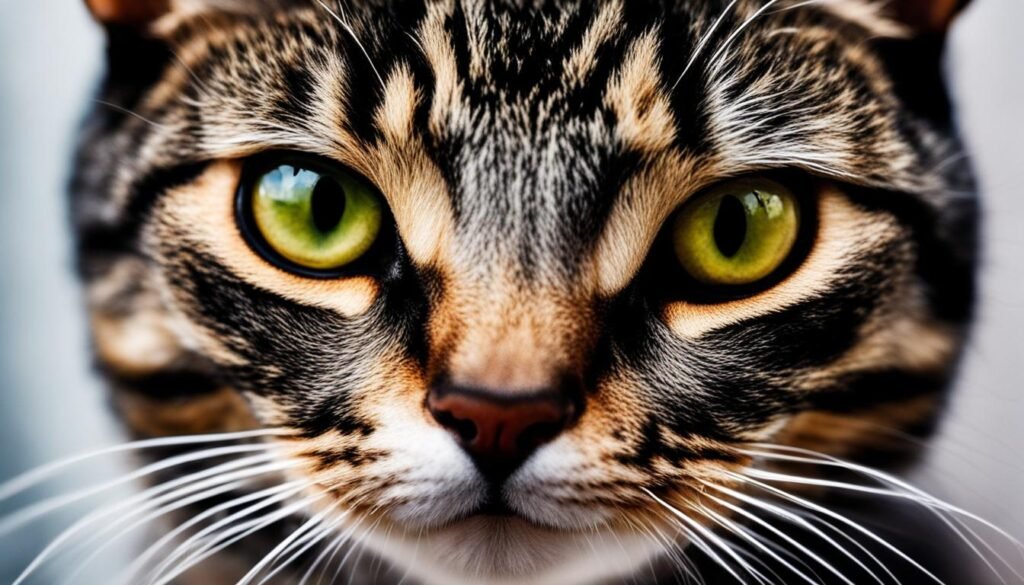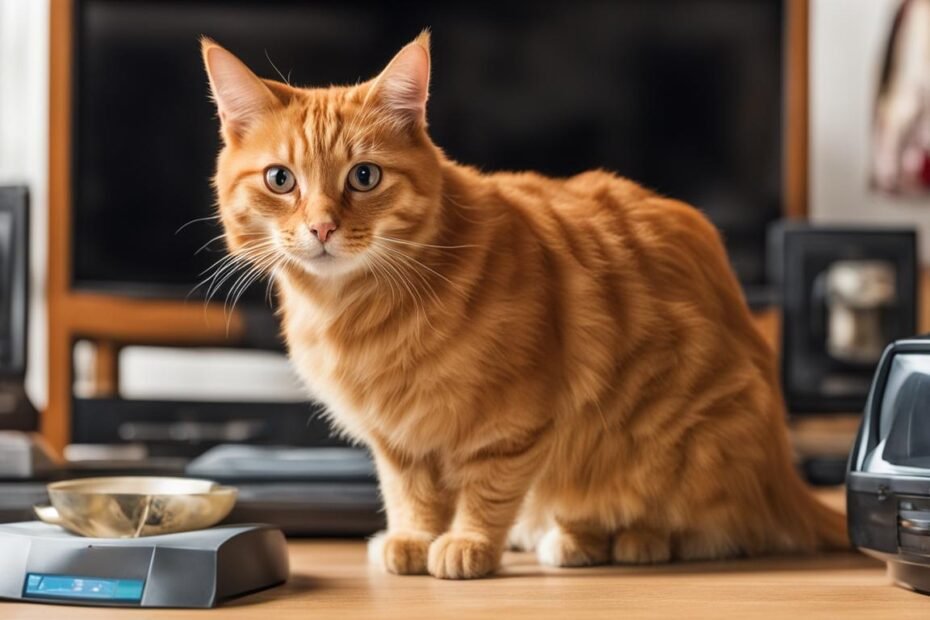Cats are subtle animals that can be great at hiding signs of stress or pain. However, stress can have a negative impact on a cat’s emotional and physical well-being. It is important for cat owners to know the signs of stress in their feline companions and take steps to reduce stress in their environment.
Some signs of cat stress include withdrawal, intolerance towards people, changes in litter box usage, changes in eating behavior, excessive meowing, hissing or growling, and physical symptoms such as vomiting or diarrhea. If a cat is exhibiting signs of stress, it is recommended to consult a veterinarian for guidance on creating a stress-free environment and possible behavior modification techniques.
Cats can become stressed for various reasons, including the presence of other pets, changes in their environment, and inappropriate handling. Understanding and addressing the cause of stress is essential for the well-being of the cat.
Key Takeaways:
- Recognize signs of cat stress: withdrawal, intolerance towards people, changes in litter box usage, changes in eating behavior, excessive meowing, hissing or growling, and physical symptoms such as vomiting or diarrhea.
- Consult a veterinarian for guidance on creating a stress-free environment and behavior modification techniques.
- Cats can become stressed due to the presence of other pets, changes in the environment, and inappropriate handling.
- Understanding and addressing the cause of stress is essential for a cat’s well-being.
Understanding the Emotional Response of Cats to Stress
Cats are highly sensitive creatures that can experience a range of emotions when they are stressed. Understanding their emotional response is crucial for ensuring their overall well-being. While cats may not express emotions such as jealousy or spite, they can feel fear, anxiety, frustration, and even depression in response to stressors in their environment.
Recognizing a cat’s emotional state is important for identifying the underlying cause of their stress. Cats may exhibit behavioral changes, physical symptoms, or display signs of discomfort. By observing their behavior and body language, cat owners can gain insights into how their feline companions are feeling and take steps to address their emotional needs.
“Our cats rely on us to create a safe and stress-free environment,” says Dr. Jane Peterson, a veterinarian specializing in feline behavior. “Understanding their emotional responses allows us to better meet their needs and provide the support they require to thrive.”
Creating a stress-free environment for cats involves minimizing potential stressors and providing them with the necessary resources to feel secure. This includes maintaining a consistent routine, offering places for hiding and relaxation, and providing appropriate outlets for play and mental stimulation. By addressing the emotional response of cats to stress, cat owners can help ensure the emotional well-being and happiness of their feline companions.
Cats’ Emotional Well-being: Tips for Creating a Stress-Free Environment
1. Maintain a consistent routine: Cats thrive on routine, so try to keep feeding times, play sessions, and daily activities consistent.
2. Provide hiding spots and safe spaces: Cats feel secure when they have places to retreat to when they feel stressed or overwhelmed.
3. Offer interactive toys and mental stimulation: Engaging your cat in play and providing puzzle toys can help alleviate boredom and reduce stress.
4. Minimize exposure to potential stressors: Avoid sudden changes in the environment, excessive noise, or interactions with other pets that may cause distress.
5. Seek professional guidance if needed: If you are unsure how to address your cat’s emotional well-being, consult with a veterinarian or feline behavior specialist for personalized advice.
| Emotional Response | Common Signs |
|---|---|
| Fear | Hiding, crouching, dilated pupils |
| Anxiety | Restlessness, excessive grooming, pacing |
| Frustration | Excessive meowing, scratching furniture, aggression |
| Depression | Social withdrawal, decreased appetite, lethargy |
Understanding and addressing the emotional response of cats to stress is essential for providing them with a nurturing and supportive environment. By being attentive to their needs and providing appropriate care, cat owners can help their feline companions lead happier, healthier lives.
Common Causes of Stress in Cats and How to Manage Them
Stress can have a significant impact on a cat’s well-being and behavior. Understanding the common causes of stress in cats and implementing effective management techniques is essential for ensuring a stress-free environment for our feline companions.
Living with Other Cats
Cats are solitary animals by nature, and living with other cats can often lead to stress and tension. Introducing cats gradually and providing separate resources, such as litter boxes and feeding areas, can help reduce competition and minimize stress. Creating vertical spaces, such as cat trees or shelves, can also provide cats with extra territory and opportunities for individualization, reducing stress levels.
The Arrival of Other Pets
Introducing a new pet, such as a dog, can be stressful for cats. Gradual introductions, allowing the animals to become familiar with each other’s scent and presence, can help reduce stress. It’s important to provide each pet with their own space and resources to prevent territorial disputes and promote a harmonious living environment.
Changes in the Environment
Cats are sensitive to changes in their environment. Moving to a new home, rearranging furniture, or undergoing construction can all cause stress in cats. Providing a quiet and safe space for your cat to retreat to can help alleviate stress. Additionally, maintaining familiar routines and offering plenty of mental and physical stimulation can help cats adapt to their changing environment more easily.
Inappropriate Handling
Excessive or improper handling can be stressful for cats. Avoid rough play or forcing physical contact with a cat that is not receptive. Understanding a cat’s body language and providing gentle and respectful interactions can help build trust and reduce stress. It’s important to teach children and visitors appropriate ways to interact with cats to ensure their well-being.
| Causes of Stress | Management Techniques |
|---|---|
| Living with other cats | – Gradual introductions – Separate resources – Providing vertical spaces |
| The arrival of other pets | – Gradual introductions – Providing individual spaces – Preventing territorial disputes |
| Changes in the environment | – Providing quiet retreat spaces – Maintaining familiar routines – Offering mental and physical stimulation |
| Inappropriate handling | – Gentle and respectful interactions – Avoiding rough play – Educating others on proper cat handling |
By understanding these common causes of stress in cats and implementing appropriate management techniques, cat owners can create a calm and stress-free environment for their furry friends. Observing and addressing signs of stress early on can help prevent the development of more severe behavioral or health issues. Remember, a happy and stress-free cat is a healthy cat.
Signs of Stress in Cats: How to Spot Them
Cats can exhibit various signs of stress, and it’s important for cat owners to be able to recognize these indicators in order to provide the necessary support for their feline companions. By spotting the signs early on, owners can address the underlying stressors and take appropriate action to ensure their cats’ well-being.
One common sign of stress in cats is a change in behavior, such as becoming more withdrawn or hiding. Cats may also become less tolerant of people, displaying aggression or avoiding certain activities they previously enjoyed. Changes in eating or drinking behavior, such as a loss of appetite or increased thirst, can also be a sign of stress.
Excessive vocalization, such as excessive meowing or growling, can indicate that a cat is feeling stressed. Physical symptoms, including exaggerated swallowing, vomiting, or diarrhea, may also manifest in response to stressors. By paying close attention to these signs, cat owners can identify when their feline companions are experiencing stress and take appropriate measures to alleviate it.

Conclusion
In conclusion, addressing cat stress is crucial for ensuring the well-being of our feline companions. By recognizing the signs of stress and understanding the underlying causes, cat owners can take proactive steps to create a stress-free environment and support their cat’s overall well-being.
Creating a stress-free environment involves managing the introduction of new pets, maintaining routines, and providing appropriate resources like clean litter boxes and quiet spaces. It is also important to address any inappropriate handling that may cause stress to your cat.
Supporting your cat’s well-being goes beyond just physical care. By observing behavioral changes and responding promptly, you can help alleviate stress and provide the necessary support to help your cat thrive. Remember, your cat’s emotional health is just as important as their physical health.
FAQ
What are the signs of stress in cats?
The signs of stress in cats can include withdrawal, intolerance towards people, changes in litter box usage, changes in eating behavior, excessive meowing, hissing or growling, and physical symptoms such as vomiting or diarrhea.
How can I reduce stress in my cat’s environment?
To reduce stress in your cat’s environment, you can create a stress-free space with appropriate resources, such as clean litter boxes and quiet areas. It may also help to identify and address any specific stressors, such as the presence of other pets or changes in the environment.
What can cause stress in cats?
Cats can become stressed for various reasons, including living with other cats, the arrival of other pets, changes in the environment, and inappropriate handling. Understanding the specific cause of stress is important for managing a cat’s overall well-being.
How can I recognize if my cat is stressed?
Cats can display various signs of stress, including becoming withdrawn, being less tolerant of people, avoiding certain activities, changes in eating behavior, excessive meowing, aggressive behavior, and physical symptoms such as exaggerated swallowing or vomiting. It’s important to be observant and recognize these signs to provide appropriate support.
How can I support my cat’s well-being and reduce stress?
Supporting your cat’s well-being and reducing stress involves creating a stress-free environment, managing the introduction of new pets, providing appropriate resources, and recognizing behavioral changes. By addressing the underlying causes of stress, you can help your cat lead a happier and healthier life.
